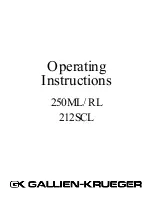
> > > > > > > > > > > > > > > > > > > > > > > > > > > > > > > > > > > > > > > > > > > > > > > > > > > > > > > > > > > > > > > > > > > >
88
\
B E D I E N E L E M E N T E
B E D I E N E L E M E N T E
B E D I E N E L E M E N T E
> > > > > > > > > > > > > > > > > > > > > > > > > > > > > > > > > > > > > > > > > > > > > > > > > > > > > > > > > > > > > > > > > > > >
11
INSTALLATION
Content of the Box
The unit was packed carefully. Nevertheless we recommend to check the
content directly after opening the package:
1 x MC-7
1 x Power cable
4 x Rubber feet
1 x Manual
Placing the Device
The unit should be set up as closely as possible to the devices to which it
will be connected, so as to avoid excessive cable lengths. Use the 4 rubber
feets enclosed with the appliance and stick them symmetrically on the
bottom side of the unit to protect the enclosure and supporting surface
from being damaged.
The device can be mounted into a standard 19“ rack and will require 1 unit.
In this case, the rubber feet cannot be attached. Install the device so that
one unit of rack space is left free both above and below the device to allow
for sufficient ventilation! The mounting depth including the terminals is
160 mm/6.7“. Another 60 mm/2.4“ should be added for the required cables.
Additional slide-in rails on the rack inside are recommended for safe instal-
lation. This will also avoid long-term mechanical deformation of the housing.
Wiring the Word Clock interfaces
To allow for the synchronization of signals, the interfaces of all devices
involved must be properly connected to each other, so as to ensure a logical
signal flow. Always be sure to connect the Word Clock output of the MC-7
to the corresponding input of the device you wish to synchronize. Cable
lengths should be kept as short as possible to minimize signal losses and/or
interferences!
For the transmission of Word Clock signals electrical, unsymmetrical cables
with a resistance of 75
Ω
and BNC connectors on both ends are used. Typi-
cally, such cables are marked »RG-59U, RG59B/U«.
Additionally, you should make sure that the Word Clock inputs to be con-
nected to the MC-7’s outputs have a 75
Ω
terminating resistor! Most Word
Clock inputs allow for enabling/disabling the termination with a so-called
»termination-switch«, which may be located on the outside or inside of the
device.
For devices which have no termination of the Word Clock input, e.g. RME
Hammerfall with Word Clock i/o, Alesis BRC or M-Audio ProFire Light-
bridge, you can use an additional BNC-T piece to terminate the input. Plug
the T piece with its center connector into the input of the receiving device.
Then, connect the cable coming from the MC-7’s Word Clock output to one
of the lateral connectors, and the other connector of the BNC-T piece to a
75
Ω
resistor forming the BNC termination.
Basically, you should avoid »looping through« Word Clock leads by means
of passive BNC-T pieces to preserve the signal quality, as level drops will be
the result. If there is no other way to wire your set-up, please make sure
that all Word Clock inputs (except for the last device in the chain) have
their terminations disabled! In a serial Word Clock chain only the last clock
input should have a termination! Never connect more than three devices in
series to one output!
Before installing the unit the section
SAFETY INSTRUCTIONS located
at the beginning of this manual
should be read carefully.
!
The condition of the packaging material
and the device should be checked carefully
additionally. If there are any damages please
refer to SAFETY INSTRUCTIONS, Initial
Operation, and WARRANTY REGULATIONS.
Never expose the device and
accessories to rain, moisture,
direct sunlight, or excessive heat
produced by radiators, heaters, or spot
lights! Sufficient air circulation in the
environment of the device must be ensured!
!
MUTEC offers optical cables of various
lengths that have been specifically tested for
the transmission of S/P-DIF signals. Ask your
local dealer for those cables!
It is imperative that the lengths
of all cables connected are largely
the same, as this is the only way to
ensure that all devices will be synchronized
in phase (exception: cable tolerances).
Please make sure that the cable used has a
resistance of 75
Ω
, in compliance with the
specifications! If a cable with a different
resistance is used, a dramatic deterioration
of the signal quality can be the result! In
this case, the perfect synchronization of all
devices involved could be impaired.
We recommend using high-grade cables with
a good shielding. A length of max. 10 meters
(approx. 30 feets) should not be exceeded!
!












































